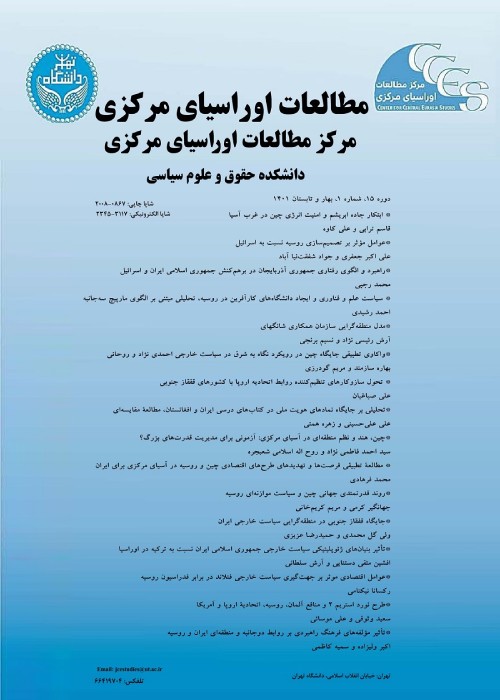Elements and Obstacles of Iran’s Geocultural Approach to China’s Belt and Road Initiative in Central Asia
The Belt and Road Initiative as the biggest and the boldest plan in China’s foreign policy is perceived as a great stride toward China’s self-expression and abandoning the legacy of Deng Xiaoping in keeping a low profile, which would have wide repercussions worldwide. This structural change will be especially felt in regional dimensions, and as the closer the regions are to China, the greater will be the effects upon them. Central Asia is a region that will be affected strongly by this initiative. China inaugurated its vast and ambitious strategy to revive the Silk Road in 2013 during a visit by Xi Jinping to Kazakhstan, which shows the importance of Central Asia as the gateway for China’s modern Silk Road. The nature of Chinese strategy is expansion of connectivity to have new routes for its exports to its main markets especially to Europe. Therefore a historic opportunity is provided for active participation by other states in this great endeavor to expand cultural interaction besides transit of goods. In this regard, Iran as a great nation in Western Asia with shared borders with Central Asia has vested interests in this region. Historically and culturally Iran has many commonalities with Central Asia. So, this question arises that what would be the best and the most efficient approach in regional foreign policy of Iran in Central Asia as a response to Belt and Road Initiative and what are its consequences? To answer this question it is argued that based on constructivism theory and its effects on new regionalism, an approach based on Cultural Iran is regarded as the best policy for Iran which in comparison with other approaches would be more beneficial in realizing the comparative advantage of Iran. Cultural Iran is a concept which differentiates between geographical and cultural domains of Iran. Based on its deep historical and civilizational roots, Iran is regarded as among those few states in the world which have wider cultural spheres than their actual geographical borders. Cultural Iran means those invisible borders that embrace the historical and cultural roots of ancient Persia are still alive and potentially revivable. Therefore, we hypothesize that the best strategy for Iran in the Belt and Road Initiative in Central Asia would be a cultural approach, based on Iran`s soft power. Furthermore, a comparative analysis of three kinds of approaches in Iran’s regional policy in Central Asia, including geopolitics, geo-economics and geo-culture will be provided. At the end, the obstacles of Iran’s geo-culture will be examined. Our assumption on the nature of the Belt and Road Initiative is that it is a multi-dimensional concept with different geopolitical, geo-economical and geo-cultural aspects. The main assumption in the West and especially in the United States is that BRI is a geopolitical strategy by China in challenging the current American and western global order. So, the best response to BRI must be a geological response based on power and show of force. On the other hand, China constantly emphasizes that BRI is exclusively an economic strategy without any geopolitical aspects. China claims that BRI is a helping hand for strengthening globalization, which is being undermined by the U.S. actions. Our assumption in this paper is that BRI is a mutually beneficial strategy for both Iran and China, and Iran is ready and willing to participate in it. However, as Iran has deep historical and civilizational roots in Central Asia which can be used as a soft power, it will be better positioned in BRI by trying to revive these ancient roots. In conclusion, we argue that Iran’s foreign policy has different expressions in different regions and sub-regions. Iran has mainly a geopolitical approach in the Middle East which is of course based on the nature of developments in this region. In South Asia, the Iranian foreign policy is most geo-economic, which is the main reason in Iran’s balanced relations with both India and Pakistan. Iran’s main strategy in this region is North-South Transportation Corridor, by the participation of India, Russia and Iran and the possibility for inclusion of Pakistan and China. At the end, it is argued that Iran’s strategy and approach in Central Asia should be mainly a geo-cultural one. This approach is proposed because Iran is not willing and able to challenge the traditional geopolitical influence of Russia in Central Asia and is not willing and able either to challenge the geo-economic influence of China in the region. However, by focusing on the Iranian historical and civilizational roots in the region, there will be no challenge for Russia and China but great benefits will be provided by this approach for the nations in the sphere of Cultural Iran. However, there are some challenges for Iran in realizing this geo-cultural approach. One of the main obstacles is the religious one, as Iran is a Shiite country and the Central Asian states are mostly Sunnis. Also, the Central Asian countries are secular states with a cautious foreign policy in relations to Iran. Although Iran has had a pragmatic approach in relation with the countries in the region and has been a great helping hand for them in difficult times, the image framed by the West regarding Iran, has been quite negative.
- حق عضویت دریافتی صرف حمایت از نشریات عضو و نگهداری، تکمیل و توسعه مگیران میشود.
- پرداخت حق اشتراک و دانلود مقالات اجازه بازنشر آن در سایر رسانههای چاپی و دیجیتال را به کاربر نمیدهد.


